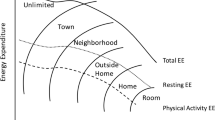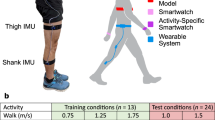Abstract
Mobility is a good indicator of health status and thus objective mobility data could be used to assess the health status of elderly patients. Accelerometry has emerged as an effective means for long-term physical activity monitoring in the elderly. However, the output of an accelerometer varies at different positions on a subject’s body, even for the same activity, resulting in high within-class variance. Existing accelerometer-based activity recognition systems thus require firm attachment of the sensor to a subject’s body. This requirement makes them impractical for long-term activity monitoring during unsupervised free-living as it forces subjects into a fixed life pattern and impede their daily activities. Therefore, we introduce a novel single-triaxial-accelerometer-based activity recognition system that reduces the high within-class variance significantly and allows subjects to carry the sensor freely in any pocket without its firm attachment. We validated our system using seven activities: resting (lying/sitting/standing), walking, walking-upstairs, walking-downstairs, running, cycling, and vacuuming, recorded from five positions: chest pocket, front left trousers pocket, front right trousers pocket, rear trousers pocket, and inner jacket pocket. Its simplicity, ability to perform activities unimpeded, and an average recognition accuracy of 94% make our system a practical solution for continuous long-term activity monitoring in the elderly.







Similar content being viewed by others
References
(1996) Physical activity and health: a report of the surgeon general. US Department of Health and Human Services, Public Health Service, Washington DC
Allen F, Ambikairajah E, Lovell N, Celler B (2006) Classification of a known sequence of motions and postures from accelerometry data using adapted gaussian mixture models. Physiol Meas 27:935–951
Asada H, Shaltis P, Reisner A, Rhee S, Hutchinson R (2003) Mobile monitoring with wearable photoplethysmographic biosensors. Eng Med Biol Mag IEEE 22(3):28–40. doi:10.1109/MEMB.2003.1213624
Bao L, Intille SS (2004) Activity recognition from user-annotated acceleration data. In: Pervasive computing. Springer, Berlin/Heidelberg, pp 158–175. doi:10.1007/b96922
Belhumeur PN, Hespanha JP, Kriegman DJ (1997) Eigenfaces vs. fisherfaces: recognition using class specific linear projection. IEEE Trans Pattern Anal Mach Intell 19(7):711–720
Bussmann JBJ, Martens WL, Tulen JHM, Schasfoort FC, van den Berg-Emons HJ, HJS (2001) Measuring daily behaviour using ambulatory accelerometry: the activity monitor. Behav Res Meth Instrum Comput 33:349–56
Celler BG, Hesketh T, Earnshaw W, Ilsar E (1994) An instrumentation system for the remote monitoring of changes in functional health status of the elderly at home. In: Proceedings of 16th annual IEEE international conference on engineering in medicine and biology society
Duda RO, Hart PE, Stork DG (2000) Pattern classification. Wiley-Interscience Publication
Ermes M, Parkka J, Mantyjarvi J, Korhonen I (2008) Detection of daily activities and sports with wearable sensors in controlled and uncontrolled conditions. IEEE Trans Inf Technol Biomed 12:20–26
Giansanti D, Macellari V, Maccioni G (2008) New neural network classifier of fall-risk based on the mahalanobis distance and kinematic parameters assessed by a wearable device. Physiol Meas 29:N11–N19
Karantonis DM, Narayanan MR, Mathie M, Lovell NH, Celler BG (2006) Implementation of a real-time human movement classifier using a tri-axial accelerometer for ambulatory monitoring. IEEE Trans Inf Technol Biomed 10(1):156–67
Kern N, Schiele B, Junker H, Lukowicz P, Troster G (2003) Wearable sensing to annotate meeting recordings. Pers Ubiquitous Comput 7:263–274
Khan AM, Lee YK, Kim TS (2008a) Accelerometer signal-based human activity recognition using augmented autoregressive model coefficients and artificial neural nets. In: Proceedings of 30th annual IEEE international conference on engineering in medicine and biology society, pp 5172–5175
Khan AM, Truc PTH, Lee YK, Kim TS (2008b) A tri-axial accelerometer sensor-based human activity recognition via augmented signal features and hierarchical recognizer. In: Proceedings of 5th international conference on ubiquitous healthcare
Korhonen I, Parkka J, Van Gils M (2003) Health monitoring in the home of the future. Eng Med Biol Mag IEEE 22(3):66–73. doi:10.1109/MEMB.2003.1213628
Lee SH, Park HD, Hong S, Lee KJ, Kim YH (2003) A study on the activity classification using a tri-axial accelerometer. In: Proceedings of 25th annual IEEE international conference on engineering in medicine and biology society, vol 3
Mantyjarvi J, Himberg J, Seppanen T (2001) Recognizing human motion with multiple acceleration sensors. In: Proceedings of 2001 IEEE international conference on systems, man, and cybernetics, vol 2, pp 747–752
Marschollek M, Wolf K, Gietzelt M, Nemitz G, Schwabedissen HMZ, Haux R (2008) Assessing elderly persons’ fall risk using spectral analysis on accelerometric data—a clinical evaluation study. In: Proceedings of 30th annual IEEE international conference on engineering in medicine and biology society, pp 3682–3685
Mathie M, Celler B, Lovell N, Coster A (2004a) Classification of basic daily movements using a triaxial accelerometer. Med Biol Eng Comput 42:679–687
Mathie MJ, Coster ACF, Lovell NH, Celler BG (2004b) A pilot study of long term monitoring of human movements in the home using accelerometry. J Telemed Telecare 10:144–151
Maurer U, Smailagic A, Siewiorek D, Deisher M (2006) Activity recognition and monitoring using multiple sensors on different body positions. In: Proceedings of international workshop on wearable and implantable body sensor networks, pp 113–116
Minnen D, Starner T, Ward J, Lukowicz P, Troester G (2005) Recognizing and discovering human actions from on-body sensor data. In: Proceedings of IEEE international conference on multimedia and expo (ICME), pp 1545–1548
Najafi B, Aminian K, Paraschiv-Ionescu A, Loew F, Büla CJ, Robert P (2003) Ambulatory system for human motion analysis using a kinematic sensor: Monitoring of daily physical activity in the elderly. IEEE Transactions on Biomedical Engineering 50(6):711–723
Narayanan MR, Scalzi ME, Redmond SJ, Lord SR, Celler BG, Lovell NH (2008) A wearable triaxial accelerometry system for longitudinal assessment of falls risk. In: Proceedings of 30th annual IEEE international conference on engineering in medicine and biology society, pp 2840–2843
Noury N, Dittmar A, Corroy C, Baghai R, J L Weber DB, Klefstat F, Blinovska A, Vaysse S, Comet B (2004) Vtamn—a smart clothe for ambulatory remote monitoring of physiological parameters and activity. In: Proceedings of 26th annual IEEE international conference on engineering in medicine and biology society
Park S, Jayaraman S (2003) Enhancing the quality of life through wearable technology. Eng Med Biol Mag IEEE 22:41–48
Peeters P (2000) Design criteria for an automatic safety-alarm system for elderly. Technol Health Care 8:81–91
Pirttikangas S, Fujinami K, Nakajima T (2006) Feature selection and activity recognition from wearable sensors. Ubiquitous Comput Syst 4239:516–27
Preece SJ, Goulermas JY, Kenney LPJ, Howard D, Meijer K, Crompton R (2009) Activity identification using body-mounted sensors–a review of classification techniques. Physiol Meas 30:R1–R33
Ravi N, Dandekar N, Mysore P, Littman ML (2005) Activity recognition from accelerometer data. In: Proceedings of 20th national Conference on artificial intelligence, pp 1541–1546
Sarela A, Korhonen I, Lotjonen J, Sola M, Myllymaki M (2003) Ist vivago ®—an intelligent social and remote wellness monitoring system for the elderly. pp 362–365. doi:0.1109/ITAB.2003.12225541
Scanaill CN, Carew S, Barralon P, Noury N, Lyons D, Lyons GM (2006) A review of approaches to mobility telemonitoring of the elderly in their living environment. Ann Biomed Eng 34:547–563
Sekine M, Tamura T, Akay M, Fujimoto T, Togawa T, Fukui Y (2002) Discrimination of walking patterns using wavelet-based fractal analysis. IEEE Trans Neural Syst Rehabil Eng 10:188–196
Sung M, Marci C, Pentland A (2005) Wearable feedback systems for rehabilitation. J Neuroeng Rehabil 2:17
Van Kasteren T, Noulas A, Englebienne G, Kröse B (2008) Accurate activity recognition in a home setting. In: UbiComp ’08: Proceedings of the 10th international conference on Ubiquitous computing, ACM, New York, NY, USA, pp 1–9. doi:10.1145/1409635.1409637
Acknowledgments
This research was supported by the MKE (The Ministry of Knowledge Economy), Korea, under the ITRC (Information Technology Research Center) support program supervised by the NIPA (National IT Industry Promotion Agency) (NIPA-2010-(C1090-1021-0003)). This work was supported by the National Research Foundation of Korea (NRF) grant funded by the Korea government (MEST) (No. 2009-1515).
Author information
Authors and Affiliations
Corresponding author
Rights and permissions
About this article
Cite this article
Khan, A.M., Lee, YK., Lee, S. et al. Accelerometer’s position independent physical activity recognition system for long-term activity monitoring in the elderly. Med Biol Eng Comput 48, 1271–1279 (2010). https://doi.org/10.1007/s11517-010-0701-3
Received:
Accepted:
Published:
Issue Date:
DOI: https://doi.org/10.1007/s11517-010-0701-3




